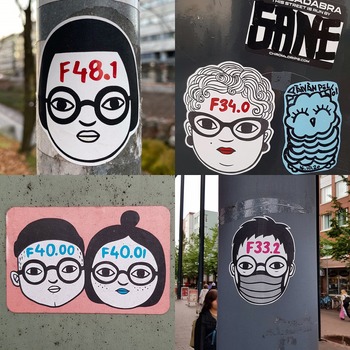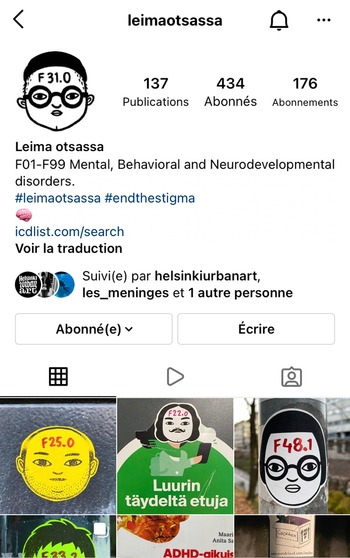Sticker art is a particular form of street art that developed in the USA during the 1980s as an alternative to tags and graffiti to escape the increasing police action against taggers. As a hobby, I enjoy finding random works of street art, whether they are frescoes, tags, collages or stickers, as I wander through a city.
A few years ago, I started to spot sticker faces with simple but distinct features, of both genders and different origins. Each face has a code in red with a capital F followed by two or three numbers (Fig. 1). At first, it could have been coincidental, but the rapid discovery of a second face with a second ICD-10 psychiatric code left no doubt: A street artist was sticking stickers in the streets of Helsinki with a message to convey. It only took a few clicks to find the artist (Leima otsassa, literally ‘the label on the forehead’, Lo) on Instagram, where Lo posts all these collages (Fig. 2). I made contact with the artist to ask about her/his experience.

Fig. 1 Examples of stickers (reproduced with the authorisation of the artist). Images – Copyright: Leima Otsassa @leimaotsassa.

Fig. 2 Instagram account of Leimaotsassa. Images – Copyright: Leima Otsassa @leimaotsassa.
Lo started in June 2019. The subject of mental health was important to Lo and Lo had been wanting to make artworks dealing with this theme for a long time. The idea of characters with a label on their forehead came to mind quite quickly. Stickers are drawn and printed at home, then Lo goes on a long walk to stick them everywhere, usually the city centre or the suburbs. Later Lo created an Instagram account that got a surprising number of followers (434 followers at the time of writing the manuscript). Lo wants to underline the stigmatisation that faces patients with psychiatric conditions in Finland (‘People see you as a diagnosis, not as a person who is more than just an ICD code’). In addition, patients face difficulties getting help in Finland and psychotherapy is expensive.
The characters are different-looking people, ordinary people that you can see walking down the street. Thus, anyone we meet may have a diagnosis that we do not know about, and it reminds everyone that there can be people with all sorts of diagnoses that pass them by every day. Despite the enigmatic aspect of the stickers (a code on a face) curious individuals look on google or others may immediately recognise the hidden meaning of the message. Lo has received a lot of positive feedback and patients even send pictures so they can have their own sticker face. Not surprisingly, Lo features among the stickers. Lo acknowledged having anxiety and agoraphobia. Sticking stickers in the streets helped Lo to cope with his/her own anxiety and agoraphobia and compares it with a mindfulness practice.
Sticker art may thus play a role for patients and shed light on psychiatric conditions and the burden of patients.
Acknowledgements
The author wishes to thank Leima otsassa warmly for kindly sharing her/his experience and giving authorisation to reproduce some of the stickers.








eLetters
No eLetters have been published for this article.